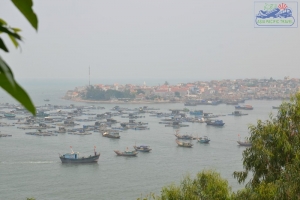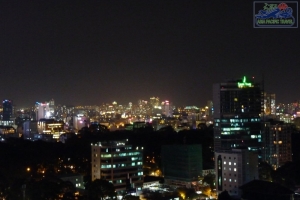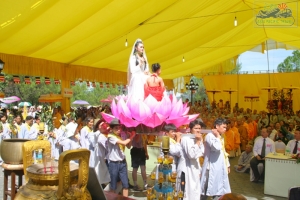
Asia Pacific Travel Team
Quang Binh Cave Festival 2015
At 20h of 14 August 2015, the opening program of Quang Binh Cave Festival 2015 themed “Quang Binh – Kingdom of caves” will take place in Quang Binh Culture Centre Square, Dong Hoi City, Quang Binh Province.
The highlight of the program is the announcement and receipt of the UNESCO certificate recognizing Phong Nha – Ke Bang National Park as World Natural Heritage Site for the second time according two new criteria: (ix) to be outstanding examples representing significant on-going ecological and biological processes in the evolution and development of terrestrial, fresh water, coastal and marine ecosystems and communities of plants and animals; (x) to contain the most important and significant natural habitats for in-situ conservation of biological diversity, including those containing threatened species of outstanding universal value from the point of view of science or conservation.
The festive part of the program is the uninterrupted connection of music and image to highlight the theme of the program, namely Quang Binh – a hero land gifted the majestic and splendor beauty by mother nature, especially the cave system honored in the world. Besides, the art performances praising the beauty of Quang Binh’s history, culture, land and people, and Quang Binh on the integration and development will be held.
Lasting for until the end of August 2015, Quang Binh Cave Festival aims to promote Quang Binh’s tourism potential, especially the special and unique values of cave system, whereby attracting foreign and domestic investors and visitors, and contributing to socio-economic development of the province. The highlight of the festival is week of “Discovering the spectacular cave system in Quang Binh Province” with many activities such as: opening of new tourist routes and sites; discount programs of tours and routes; famtrips…
In the framework of the festival, “Cuisine and specialties of Quang Binh 2015” fair aims to introduce, promote and sell local traditional handicrafts and culinary specialties.
To the festival, visitors also have the opportunity to participate in many activities such as tours of “Discovering lake through mountains”, “Conquering Toi (Dark) Cave”; sailing, climbing, conquering adventure bridge… In particular, on this occasion, Phong Nha – Ke Bang Tourist Centre will receive Viet Nam Guinness Record certificate of the longest two-wire zip line route in Viet Nam for Chay River – Toi Cave.
Thu Giang
Ancient Duong Lam Village gets a new reading corner
Nearly 500 books were donated by a local gift shop, Le Chalet Cafe, to create a reading corner for the community of ancient Duong Lam village, located in the outskirts of Ha Noi.
The reading corner sits inside the Mong Phu temple, located near the village's main entrance. The new space opens to the community today.
The ancient village of Duong Lam has well-known Laterite Museum and is home to a few hundred lateritic brick houses built three to four centuries ago.
Le Chalet Cafe is a gift shop that supports and sells handicrafts and art products made by traditional artisans from minority ethnic groups and craft villages in Viet Nam.
Source: VNS
Tu Cung Memorial House reopened for visitors
After a period of refurbishment and remodeling, recently, Hue Monuments Conservation Centre has reopened Tu Cung Memorial House (145 Phan Dinh Phung Street, Hue City) to serve visitors.
This activity aims to introduce the cultural work marked by Lady Tu Cung or Queen Mother Doan Huy (King Khai Dinh’s wife and King Bao Dai’s mother), at the same time diversify attractions for visitors in the journey of learning history – culture of the complex of Hue monuments.
To Tu Cung Memorial House, visitors have the opportunity to see photos and documents on King Khai Dinh, Lady Tu Cung, King Bao Dai’s family and Ton Nhan Phu (Imperial Clan Court – an responsible institution for all matters pertaining to the imperial family). In addition, visitors can also learn the history of the house and the stories about life of the queen mother.
In the 2nd floor of the house, apart from the centre room for dedicating to Lady Tu Cung, there are 1 largest room for general meetings and 1 library room of Executive Council of Nguyen Phuc’s Family (the royal family of Nguyen Dynasty). The remaining rooms are arranged tables and chairs for visitors and local people to study and learn Nguyen Phuc Family’s genealogy, Nguyen Dynasty and Hue culture.
Tu Cung Memorial House is directed to connect with Khai Tuong Lau and An Dinh Palace to form the tourist route for learning the life of King Bao Dai’s family – the last king of Nguyen Dynasty.
In 1955, after Ngo Dinh Diem Government confiscated An Dinh Palace – the isolated palace of Lady Tu Cung, she bought the house of Lady An Phi (one of wives of King Khai Dinh) at 79B Phan Dinh Phung Street (now 145 Phan Dinh Phung Street) to live until day of her death (10 November 1980).
Lady Tu Cung had some house’s structures improved and interior decorated in modern style. In the living room, photos of her family members and photo of President Ho Chi Minh with Supreme Advisor Vinh Thuy in President Palace (Ha Noi) in 1945 are displayed. A valuable collection of her possessions as ancient objects dating back to the reigns of King Thieu Tri, King Tu Duc… are still held in the house.
Tu Cung Memorial House is imprinted by architectural styles of the Eastern and Western cultures, marking a transitional period of Vietnamese house architecture.
Thu Giang
Nha Trang to offer the night swimming beach
Visitors to Nha Trang will have an opportunity to swim at night under the supervision of the rescue personnel, according to a plan approved recently by the local administration.
Accordingly, the night-swimming beach will remain open from 6.30pm to 10.30pm every day from early August onwards, in front of 32-34 hotel on Tran Phu Street.
The stretch available for free night-swimming will be 120m long and 50m wide. Funds incurred upon managing the zone will come from the local budget for socialisation.
The local authority has ordered TD Corporation, which proposes and takes charge of the plan, to build observatories, prepare medical equipments, install more lighting systems and arrange lifeboats and lifeguard personnel to ensure safety.
Additionally, the corporation will also be responsible for environment, security and safety. All the equipment to be used during the night swimming hours will have to be cleaned and readied for use after 10.30pm for the next day.
According to the local authority, the night-swimming zone is a public beach, where the local people and tourists can go swimming for free. However, many people used to go swimming at night without any light system and lifeguards, which is a very dangerous practice.
Earlier, at the end of 2014, the management board of Nha Trang Beach had proposed to invest in a free night-swimming zone in front of April 2nd Square, a move that has not been approved yet.
Source: VNS
Lam Dong greets 1 million visitors
The Tay Nguyen (Central Highlands) province of Lam Dong welcomed more than 1 million tourists in June and July, the country's peak tourism period, according to the province's Department of Culture, Sports and Tourism.
This summer, Da Lat has organised many activities to attract tourists. The city will hold the Mua Pho Nui (Rain in Mountain City) festival this month.
Da Lat, known as the City of Flowers, is home to Love Valley, King Bao Dai's Palace and Truc Lam Temple, among other sites.
Several famous flower villages, including Thai Phien, Van Thanh and Ha Dong, are located in Da Lat. They offer tours to visitors, who can lend a hand to flower growers on their fields.
Source: VNS
The pole raising ritual of Cotu people in Quang Nam
The Neu pole raising ritual and Gu worship objects set that has been practiced by generations of the Cor ethnic group in central Quang Nam province is now part of the national intangible heritage.
The latest population census showed that there are nearly 39,000 Cor people residing across Viet Nam, including 5,300 in Quang Nam’s mountainous areas, mostly in the Tra Kot and Tra Nu communes of Bac Tra My district. They speak the Mon-Khmer language and hold a high spirit of traditional customs preservation.
The Neu pole raising ritual and a set of worshipping objects called “Gu” are the most distinctive features of the local spiritual life with their indispensable involvement in all important rites, such as harvests and prayers to ancestors and God.
There are three kinds of Neu poles to serve different worshipping figures including local ancestors and old gods that control their surrounding nature. With average heights ranging from 5-9 metres, the wooden posts are engraved with colourful images of the sun, the moon, mountains, streams, villages, crops and livestock. It carries an offering salver, glass beads and a sacred object among others. A sacred object is placed atop the pole and has different forms based on its reflections of the worshiping figures’ positions. Crafting Neu poles is labour intensive and often takes months to complete.
A favourable date is picked for an offering ritual of local specialties and domestic animals to invite ancestors and Gods before the Neu pole. The service is often organised by a rich family that then attracts other villagers who contribute rice, wine, chickens and pigs. The host will then sacrifice the animals and prepare a feast to serve their invited spiritual figures, sharing the food among the community and with their honourable guests.
Meanwhile, the Gu set is hung inside the house of the host. One item - the Gu Mok - is suspended on the main door for good luck while another more sophisticated item - Gu Bla - hangs in the middle of the house for gods and ancestors to sit on and receive the offerings laid beneath. The Gu MoK Tum is hung at the kitchen door and the Gu Tum, in the centre of the kitchen.
Source: VNA
Exploring the west of Yen Tu Mountain
Bac Giang is not a well-known destination for tourists due to few places of interest. But if you happen to be in this northern province, you should come to explore Mo Stream and Thum Thum Waterfall on the western side of Yen Tu Mountain.
The west of Yen Tu is in Nghia Phuong Commune, Luc Nam District. To get there, you can start the journey from Hanoi and travel more than 80 kilometers on National Highway 31 and Provincial Road 293.
We made a trip to Mo Stream on the foot of Huyen Dinh Mountain to see how it is. After a long journey on a hot summer day, we felt relaxed and enjoyed looking at the stream, which flows through lots of rocks.
A female vendor of drinks and snacks in the area, who identified herself as Mai, said: “The area around the stream is very slippery. You should be watchful when walking on the rocks. The surfaces of the rocks are so greasy that the stream is called “mo” (which means fat). It is as if the area were covered with fat.”
Aside from the breathtaking landscape with a lot of trees, the site is ideal for those practicing Zen. Along the stream are many temples such as Ha, Trung, Thuong, Tran and Quan built to worship people who had contributed to reclaiming the region and kings who had helped protect and develop the country.
The area behind Ha temple has a large orchid tree. Claimed to be more than 200 years old, the tree aromatizes the whole area thanks to its pleasant fragrance when in bloom.
After a sightseeing tour of Mo Stream area, we continued our trip by exploring Thum Thum Waterfall in the upstream of Mo Stream.
To get to the top of the waterfall, we negotiated a seven-kilometer sloping path.
Located on the peak of Huyen Dinh Mountain, Thum Thum Waterfall pours down into the low-lying area, creating natural pools for tourists to enjoy themselves in the cool and clear water.
It is quite easy to climb from the first level to the second level of the waterfall, which comprises four levels. However, it becomes more difficult to reach higher levels.
From the second level, we climbed a rope ladder which is around ten meters long to reach the third level, a perfect spot with shades of big trees and puddles of crystal-clear water. Those who want to stand on the top of the waterfall will have to climb on a giant rock which is around four meters high.
Source: SGT
Thanh Hoa targets 403 million USD from tourism by 2020
The north central province of Thanh Hoa has set its sights on earning 403 million USD from tourism by 2020.
Pham Dang Quyen, Vice Chairman of the provincial People’s Committee, said the province’s goal is to attract from 200,000-250,000 international tourists and 8-9 million local visitors by 2020 with combined revenues of 403 million USD.
The province, however, will face an uphill battle in improving infrastructures, diversifying tourist products and developing a civilised tourism environment.
By the end of June 2015, Thanh Hoa had welcomed 3.3 million holidaymakers, up 16.2 percent against the same period last year, 57,700 of whom are international tourists, up 26 percent.
Tourism revenue reached 3.36 trillion VND (154 million USD), up 22.7 percent, 37.9 million USD of which was from international visitors.
Thanh Hoa currently has 672 accommodation establishments with 15,000 rooms, 85 of which are one to four-star hotels.
The Sam Son Beach alone has over 400 accommodation facilities with 12,000 rooms. The FLC Sam Son Beach and Golf Resort has more than 600 five-star rooms.
Source: VNA
Tourism decline hits HCM City hotel market
A slump in tourism has hit Ho Chi Minh City's hotel market, which saw a drop in the average rate of reserved rooms in the first six months of the year compared to the previous five years.
In its recent report, Savills Vietnam, which provides comprehensive property services, said the hotel market had seen the lowest average room rate in the last five years due to a continuous increase in supply and fierce competition in the market.
For the second quarter of the year, the average room rate dropped 5 percent compared to the first quarter and 3 percent year-on-year to 1.6 million VND (78 USSD) per room per night.
According to the report, the city in the second quarter added 540 rooms in the three-star segment with six new and one refurbished hotels. The five-star segment had 446 additional rooms from an existing hotel and an upgraded hotel.
As of the end of the second quarter, the city had a total of 106 hotels supplying 13,800 rooms, increasing 6 percent quarter-on-quarter and 10 percent year-on-year.
In the first quarter, three- to five-star hotels had a soft performance year-on-year.
The average occupancy was 70 percent, up two percentage points quarter-on-quarter but down four percentage points year-on-year.
All three grades incurred a year-on-year decrease in occupancy.
The four-star segment had the highest occupancy drop of six percentage points. The three- and five-star segment decreased by four percentage points each.
The average room rate was 1.8 million VND (82 USD) per room per night, down 5 percent quarter-on-quarter and 7 percent year-on-year.
In the central region, in the first quarter, the average room rate of hotels in Da Nang city dropped 5 percent against 2014 to 1.75 million VND per room per night, while the revenue per available room (RevPAR), a standard industry measure of room utilisation and return, showed a 12 percent decrease.
The overall occupancy decreased four percentage points against 2014 to 48 percent.
Fifty-six 3- to 5-star hotels supplied about 6,450 rooms, up 7 percent against 2014.
According to the 2015 Vietnam Hotel Survey of 60 4- to 5-star hotels conducted by the UK-owned audit and consultancy firm Grant Thornton Vietnam from March to June, RevPAR experienced a slight decrease of 1.8 percent from 60.42 USD in 2013 to 59.31 USD last year.
The decrease was attributed to a drop of 2 percent in average occupancy, it said.
Data breakdowns showed that while average occupancy rates of 4- and 5-star hotels rose 6.7 percent year-on-year in Hanoi, the rates fell 6.7 percent compared with the previous year in HCM City.
Source: VNA
People flock to Thua Thien Hue in Bodhisattva Festival
Thousands of Buddhist monks, followers and tourists flocked to the Quan The Am (Avalokitesvara Bodhisattva) festival that opened in the central province of Thua Thien-Hue on August 3, or the 19th day of the sixth lunar month.
The festival includes a ceremony to pray for peace of the nation with balloon and pigeon release and other activities featuring Buddhist culture, including incense offerings.
The annual event was held at the Quan The Am Buddhist Spiritual Tourism Centre in the town of Huong Thuy by the provincial chapter of the Viet Nam Buddhist Sangha’s Executive Committee.
On the occasion, the chapter organised a ceremony to commence the construction of 32 six-metre-high Bodhisattva statues made of natural granite.
Source: VNA















































































































